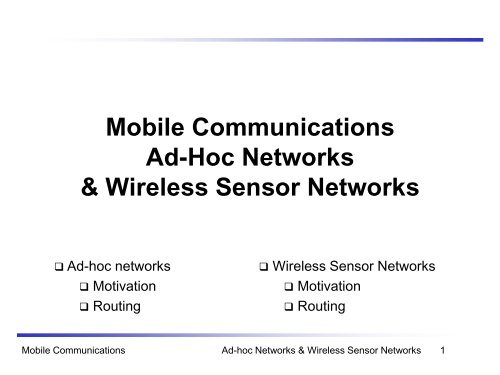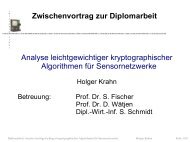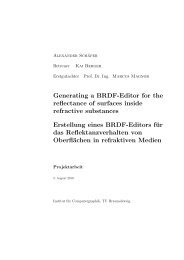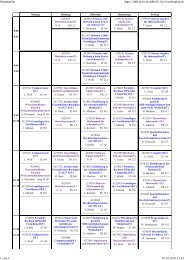Mobile Communications Ad-Hoc Networks & Wireless Sensor ...
Mobile Communications Ad-Hoc Networks & Wireless Sensor ...
Mobile Communications Ad-Hoc Networks & Wireless Sensor ...
Create successful ePaper yourself
Turn your PDF publications into a flip-book with our unique Google optimized e-Paper software.
<strong>Mobile</strong> <strong>Communications</strong><br />
<strong>Ad</strong>-<strong>Hoc</strong> <strong>Networks</strong><br />
& <strong>Wireless</strong> <strong>Sensor</strong> <strong>Networks</strong><br />
<strong>Ad</strong>-hoc networks<br />
Motivation<br />
Routing<br />
<strong>Wireless</strong> <strong>Sensor</strong> <strong>Networks</strong><br />
Motivation<br />
Routing<br />
<strong>Mobile</strong> <strong>Communications</strong> <strong>Ad</strong>-hoc <strong>Networks</strong> & <strong>Wireless</strong> <strong>Sensor</strong> <strong>Networks</strong> 1
<strong>Mobile</strong> ad hoc networks: Motivation<br />
Standard <strong>Mobile</strong> IP needs an infrastructure<br />
Home Agent/Foreign Agent in the fixed network<br />
DNS, routing etc. are not designed for mobility<br />
Sometimes there is no infrastructure!<br />
remote areas, ad-hoc meetings, disaster areas<br />
cost can also be an argument against an infrastructure!<br />
Without infrastructure, how can data reach destination node, which path is<br />
suitable? routing<br />
no default router available<br />
every node should be able to forward<br />
A B C<br />
<strong>Mobile</strong> <strong>Communications</strong> <strong>Ad</strong>-hoc <strong>Networks</strong> & <strong>Wireless</strong> <strong>Sensor</strong> <strong>Networks</strong> 2
Solution: <strong>Wireless</strong> & <strong>Mobile</strong> ad-hoc networks<br />
Network without infrastructure<br />
Use components of participants for networking<br />
Examples<br />
Single-hop: All partners max. one hop apart<br />
• Bluetooth piconet, PDAs in a room,<br />
gaming devices…<br />
Multi-hop: Cover larger distances,<br />
circumvent obstacles<br />
• Bluetooth scatternet, TETRA police network,<br />
car-to-car networks…<br />
Internet: MANET (<strong>Mobile</strong> <strong>Ad</strong>-hoc Networking) group<br />
<strong>Mobile</strong> <strong>Communications</strong> <strong>Ad</strong>-hoc <strong>Networks</strong> & <strong>Wireless</strong> <strong>Sensor</strong> <strong>Networks</strong> 3
MANET Characteristics I<br />
Highly dynamic network topology<br />
Device mobility plus varying channel quality<br />
Partitioning and merging of networks possible<br />
Asymmetric connections possible<br />
risk of packet loss<br />
N 7 N 6<br />
N 6<br />
N 7<br />
N 1 N 1<br />
N 2<br />
N 3<br />
N 4<br />
N 5<br />
N 4<br />
N 2<br />
N 5<br />
N 3<br />
time = t 1 time = t 2<br />
good link<br />
weak link<br />
<strong>Mobile</strong> <strong>Communications</strong> <strong>Ad</strong>-hoc <strong>Networks</strong> & <strong>Wireless</strong> <strong>Sensor</strong> <strong>Networks</strong> 5
MANET Characteristics II<br />
<strong>Wireless</strong> medium is broadcast medium<br />
Hidden and exposed nodes<br />
Limited battery capacities of mobile devices<br />
Amplified by signaling traffic, e.g., due to routing protocol messages<br />
Limited bandwidth<br />
Amplified by signaling traffic, e.g., due to routing protocol messages and by<br />
MAC protocol (collisions, hidden nodes, …)<br />
Time synchronisation of devices is difficult<br />
Energy saving becomes more difficult, e.g., periodic sleeping<br />
Security methods are more difficult to apply<br />
Interception of wireless channel<br />
Every device must be able to forward packets to other devices
Traditional routing algorithms<br />
Distance Vector<br />
periodic exchange of messages with all physical neighbors that contain<br />
information about who can be reached at what distance<br />
selection of the shortest path if several paths available<br />
Link State<br />
periodic notification of all routers about the current state of all physical links<br />
router get a complete picture of the network<br />
Example<br />
ARPA packet radio network (1973), DV-Routing<br />
every 7.5s exchange of routing tables including link quality<br />
updating of tables also by reception of packets<br />
routing problems solved with limited flooding<br />
<strong>Mobile</strong> <strong>Communications</strong> <strong>Ad</strong>-hoc <strong>Networks</strong> & <strong>Wireless</strong> <strong>Sensor</strong> <strong>Networks</strong> 7
Problems of traditional routing algorithms<br />
Dynamics of the topology<br />
frequent changes of connections, connection quality, participants<br />
Limited performance of mobile systems<br />
periodic updates of routing tables need energy without contributing to the<br />
transmission of user data, sleep modes difficult to realize<br />
limited bandwidth of the system is reduced even more due to the exchange<br />
of routing information<br />
links can be asymmetric, i.e., they can have a direction dependent<br />
transmission quality<br />
<strong>Mobile</strong> <strong>Communications</strong> <strong>Ad</strong>-hoc <strong>Networks</strong> & <strong>Wireless</strong> <strong>Sensor</strong> <strong>Networks</strong> 8
Routing in MANETs<br />
THE big topic in many research projects<br />
Far more than 50 different proposals exist<br />
The most simplest one: Flooding!<br />
Reasons<br />
Classical approaches from fixed networks fail<br />
• Very slow convergence, large overhead<br />
High dynamicity, low bandwidth, low computing power<br />
Metrics for routing<br />
Minimal<br />
• Number of nodes, loss rate, delay, congestion, interference …<br />
Maximal<br />
• Stability of the logical network, battery run-time, time of connectivity …<br />
<strong>Mobile</strong> <strong>Communications</strong> <strong>Ad</strong>-hoc <strong>Networks</strong> & <strong>Wireless</strong> <strong>Sensor</strong> <strong>Networks</strong> 9
Overview MANET routing protocols<br />
Flooding for data transport<br />
Simplest „protocol“: every node forwards every packet<br />
Huge overhead<br />
Table-driven / Proactive routing<br />
Maintain routes to all other nodes permanently<br />
Constant, high signalling overhead<br />
On-demand-driven / Reactive routing<br />
Routes are discovered if needed<br />
Delayed packet forwarding since route must be established first<br />
Signalling overhead depends on traffic patterns<br />
Hybrid routing<br />
Mixture of proactive and reactive routing<br />
There is not „one single best“ routing protocol for MANETs<br />
Decision about „best“ depends on scenario
Classification of MANET routing protocols<br />
Unicast routing protocols<br />
for MANETs<br />
(topologie-based)<br />
Table-driven/<br />
pro-active<br />
Hybrid<br />
On-Demand<br />
-driven/reactive<br />
Cluster-based/<br />
hierarchical<br />
Distance-<br />
Vector<br />
• DSDV<br />
• ...<br />
Link-<br />
State<br />
• OLSR<br />
• TBRPF<br />
• FSR<br />
• STAR<br />
• ...<br />
• ZRP<br />
• ...<br />
• DSR<br />
• AODV<br />
• TORA<br />
• ...<br />
not covered: position-based routing protocols<br />
• LANMAR<br />
• CEDAR<br />
• ...
Abbreviations MANET routing protocols<br />
DSDV<br />
OLSR<br />
TBRPF<br />
FSR<br />
STAR<br />
ZRP<br />
DSR<br />
AODV<br />
TORA<br />
LANMAR<br />
CEDAR<br />
Destination-Sequenced Distance Vector<br />
Optimized Link State Routing<br />
Topology Broadcast based on Reverse-Path Forwarding<br />
Fisheye State Routing<br />
Source Tree <strong>Ad</strong>aptive Routing<br />
Zone Routing Protocol<br />
Dynamic Source Routing<br />
<strong>Ad</strong> <strong>Hoc</strong> On Demand Distance Vector<br />
Temporally-Ordered Routing Algorithm<br />
Landmark <strong>Ad</strong> <strong>Hoc</strong> Routing<br />
Core-Extraction Distributed <strong>Ad</strong> <strong>Hoc</strong> Routing
DSDV (Destination Sequenced Distance Vector)<br />
Early work<br />
on demand version: AODV<br />
Expansion of distance vector routing<br />
Sequence numbers for all routing updates<br />
assures in-order execution of all updates<br />
avoids loops and inconsistencies<br />
Decrease of update frequency<br />
store time between first and best announcement of a path<br />
inhibit update if it seems to be unstable (based on the stored time values)<br />
<strong>Mobile</strong> <strong>Communications</strong> <strong>Ad</strong>-hoc <strong>Networks</strong> & <strong>Wireless</strong> <strong>Sensor</strong> <strong>Networks</strong> 13
Dynamic source routing I<br />
Split routing into discovering a path and maintaining a path<br />
Discover a path<br />
only if a path for sending packets to a certain destination is needed and no<br />
path is currently available<br />
Maintaining a path<br />
only while the path is in use one has to make sure that it can be used<br />
continuously<br />
No periodic updates needed!<br />
<strong>Mobile</strong> <strong>Communications</strong> <strong>Ad</strong>-hoc <strong>Networks</strong> & <strong>Wireless</strong> <strong>Sensor</strong> <strong>Networks</strong> 14
Dynamic source routing II<br />
Path discovery<br />
broadcast a packet with destination address and unique ID<br />
if a station receives a broadcast packet<br />
• if the station is the receiver (i.e., has the correct destination address) then return<br />
the packet to the sender (path was collected in the packet)<br />
• if the packet has already been received earlier (identified via ID) then discard<br />
the packet<br />
• otherwise, append own address and broadcast packet<br />
sender receives packet with the current path (address list)<br />
Optimizations<br />
limit broadcasting if maximum diameter of the network is known<br />
caching of address lists (i.e. paths) with help of passing packets<br />
• stations can use the cached information for path discovery (own paths or paths<br />
for other hosts)<br />
<strong>Mobile</strong> <strong>Communications</strong> <strong>Ad</strong>-hoc <strong>Networks</strong> & <strong>Wireless</strong> <strong>Sensor</strong> <strong>Networks</strong> 15
DSR: Route Discovery<br />
Sending from C to O<br />
P<br />
R<br />
C<br />
G<br />
Q<br />
A<br />
B<br />
E<br />
H<br />
I<br />
K<br />
M<br />
O<br />
D<br />
F<br />
J<br />
L<br />
N<br />
<strong>Mobile</strong> <strong>Communications</strong> <strong>Ad</strong>-hoc <strong>Networks</strong> & <strong>Wireless</strong> <strong>Sensor</strong> <strong>Networks</strong> 16
DSR: Route Discovery<br />
Broadcast<br />
P<br />
R<br />
[O,C,4711]<br />
C<br />
[O,C,4711]<br />
G<br />
Q<br />
A<br />
B<br />
E<br />
H<br />
I<br />
K<br />
M<br />
O<br />
D<br />
F<br />
J<br />
L<br />
N<br />
<strong>Mobile</strong> <strong>Communications</strong> <strong>Ad</strong>-hoc <strong>Networks</strong> & <strong>Wireless</strong> <strong>Sensor</strong> <strong>Networks</strong> 17
DSR: Route Discovery<br />
P<br />
R<br />
[O,C/B,4711]<br />
C<br />
[O,C/G,4711]<br />
G<br />
[O,C/G,4711]<br />
Q<br />
A<br />
B<br />
E<br />
[O,C/E,4711]<br />
H<br />
I<br />
K<br />
M<br />
O<br />
D<br />
F<br />
J<br />
L<br />
N<br />
<strong>Mobile</strong> <strong>Communications</strong> <strong>Ad</strong>-hoc <strong>Networks</strong> & <strong>Wireless</strong> <strong>Sensor</strong> <strong>Networks</strong> 18
DSR: Route Discovery<br />
P<br />
R<br />
C<br />
G<br />
Q<br />
A<br />
[O,C/B/A,4711]<br />
B<br />
D<br />
E<br />
F<br />
H<br />
I<br />
[O,C/G/I,4711]<br />
K<br />
[O,C/E/H,4711]<br />
L<br />
J<br />
M<br />
N<br />
O<br />
[O,C/B/D,4711]<br />
(alternatively: [O,C/E/D,4711])<br />
<strong>Mobile</strong> <strong>Communications</strong> <strong>Ad</strong>-hoc <strong>Networks</strong> & <strong>Wireless</strong> <strong>Sensor</strong> <strong>Networks</strong> 19
DSR: Route Discovery<br />
P<br />
R<br />
C<br />
G<br />
Q<br />
A<br />
B<br />
E<br />
H<br />
I<br />
[O,C/G/I/K,4711]<br />
K<br />
M<br />
O<br />
D<br />
F<br />
J<br />
L<br />
N<br />
[O,C/B/D/F,4711]<br />
[O,C/E/H/J,4711]<br />
<strong>Mobile</strong> <strong>Communications</strong> <strong>Ad</strong>-hoc <strong>Networks</strong> & <strong>Wireless</strong> <strong>Sensor</strong> <strong>Networks</strong> 20
DSR: Route Discovery<br />
P<br />
R<br />
C<br />
G<br />
Q<br />
A<br />
B<br />
E<br />
H<br />
I<br />
K<br />
[O,C/G/I/K/M,4711]<br />
M<br />
O<br />
D<br />
F<br />
J<br />
L<br />
N<br />
[O,C/E/H/J/L,4711]<br />
(alternatively: [O,C/G/I/K/L,4711])<br />
<strong>Mobile</strong> <strong>Communications</strong> <strong>Ad</strong>-hoc <strong>Networks</strong> & <strong>Wireless</strong> <strong>Sensor</strong> <strong>Networks</strong> 21
DSR: Route Discovery<br />
P<br />
R<br />
C<br />
G<br />
Q<br />
A<br />
B<br />
E<br />
H<br />
I<br />
K<br />
M<br />
O<br />
D<br />
F<br />
J<br />
L<br />
N<br />
[O,C/E/H/J/L/N,4711]<br />
<strong>Mobile</strong> <strong>Communications</strong> <strong>Ad</strong>-hoc <strong>Networks</strong> & <strong>Wireless</strong> <strong>Sensor</strong> <strong>Networks</strong> 22
DSR: Route Discovery<br />
P<br />
R<br />
C<br />
G<br />
Q<br />
A<br />
B<br />
E<br />
H<br />
I<br />
K<br />
Path: M, K, I, G<br />
M<br />
O<br />
D<br />
F<br />
J<br />
L<br />
N<br />
<strong>Mobile</strong> <strong>Communications</strong> <strong>Ad</strong>-hoc <strong>Networks</strong> & <strong>Wireless</strong> <strong>Sensor</strong> <strong>Networks</strong> 23
Dynamic Source Routing III<br />
Maintaining paths<br />
after sending a packet<br />
• wait for a layer 2 acknowledgement (if applicable)<br />
• listen into the medium to detect if other stations forward the packet (if possible)<br />
• request an explicit acknowledgement<br />
if a station encounters problems it can inform the sender of a packet or<br />
look-up a new path locally<br />
<strong>Mobile</strong> <strong>Communications</strong> <strong>Ad</strong>-hoc <strong>Networks</strong> & <strong>Wireless</strong> <strong>Sensor</strong> <strong>Networks</strong> 24
Interference-based routing<br />
Routing based on assumptions about interference between signals<br />
N 1<br />
N 2<br />
R 1<br />
S 1<br />
N 5<br />
N 3<br />
N 4<br />
N 6<br />
R 2<br />
S 2<br />
N 9<br />
neighbors<br />
(i.e. within radio range)<br />
N 7<br />
N 8<br />
<strong>Mobile</strong> <strong>Communications</strong> <strong>Ad</strong>-hoc <strong>Networks</strong> & <strong>Wireless</strong> <strong>Sensor</strong> <strong>Networks</strong> 25
Examples for interference based routing<br />
Least Interference Routing (LIR)<br />
calculate the cost of a path based on the number of stations that can<br />
receive a transmission<br />
Max-Min Residual Capacity Routing (MMRCR)<br />
calculate the cost of a path based on a probability function of successful<br />
transmissions and interference<br />
Least Resistance Routing (LRR)<br />
calculate the cost of a path based on interference, jamming and other<br />
transmissions<br />
LIR is very simple to implement, only information from direct neighbors is<br />
necessary<br />
<strong>Mobile</strong> <strong>Communications</strong> <strong>Ad</strong>-hoc <strong>Networks</strong> & <strong>Wireless</strong> <strong>Sensor</strong> <strong>Networks</strong> 26
A plethora of ad hoc routing protocols<br />
Flat<br />
<br />
<br />
proactive<br />
• FSLS – Fuzzy Sighted Link State<br />
• FSR – Fisheye State Routing<br />
• OLSR – Optimised Link State Routing Protocol<br />
• TBRPF – Topology Broadcast Based on Reverse Path Forwarding<br />
reactive<br />
• AODV – <strong>Ad</strong> hoc On demand Distance Vector<br />
• DSR – Dynamic Source Routing<br />
Hierarchical<br />
CGSR – Clusterhead-Gateway Switch Routing<br />
<br />
<br />
<br />
HSR – Hierarchical State Routing<br />
LANMAR – Landmark <strong>Ad</strong> <strong>Hoc</strong> Routing<br />
ZRP – Zone Routing Protocol<br />
Geographic position assisted<br />
DREAM – Distance Routing Effect Algorithm for Mobility<br />
<br />
<br />
<br />
GeoCast – Geographic <strong>Ad</strong>dressing and Routing<br />
GPSR – Greedy Perimeter Stateless Routing<br />
LAR – Location-Aided Routing<br />
<strong>Mobile</strong> <strong>Communications</strong> <strong>Ad</strong>-hoc <strong>Networks</strong> & <strong>Wireless</strong> <strong>Sensor</strong> <strong>Networks</strong> 27
Further difficulties and research areas<br />
Auto-Configuration<br />
Assignment of addresses, function, profile, program, …<br />
Service discovery<br />
Discovery of services and service providers<br />
Multicast<br />
Transmission to a selected group of receivers<br />
Quality-of-Service<br />
Maintenance of a certain transmission quality<br />
Power control<br />
Minimizing interference, energy conservation mechanisms<br />
Security<br />
Data integrity, protection from attacks (e.g. Denial of Service)<br />
Scalability<br />
10 nodes? 100 nodes? 1000 nodes? 10000 nodes?<br />
Integration with fixed networks<br />
<strong>Mobile</strong> <strong>Communications</strong> <strong>Ad</strong>-hoc <strong>Networks</strong> & <strong>Wireless</strong> <strong>Sensor</strong> <strong>Networks</strong> 28
The next step: <strong>Wireless</strong> <strong>Sensor</strong> <strong>Networks</strong> (WSN)<br />
Commonalities with MANETs<br />
Self-organization, multi-hop<br />
Typically wireless, should be energy efficient<br />
Differences to MANETs<br />
Applications: MANET more powerful, more general<br />
↔ WSN more specific<br />
Devices: MANET more powerful, higher data rates, more resources<br />
↔ WSN rather limited, embedded, interacting with environment<br />
Scale: MANET rather small (some dozen devices)<br />
↔ WSN can be large (thousands)<br />
Basic paradigms: MANET individual node important, ID centric<br />
↔ WSN network important, individual node may be dispensable, data<br />
centric<br />
Mobility patterns, Quality-of Service, Energy, Cost per node …<br />
<strong>Mobile</strong> <strong>Communications</strong> <strong>Ad</strong>-hoc <strong>Networks</strong> & <strong>Wireless</strong> <strong>Sensor</strong> <strong>Networks</strong> 30
Properties of wireless sensor networks<br />
<strong>Sensor</strong> nodes (SN) monitor and control the environment<br />
Nodes process data and forward data via radio<br />
Integration into the environment, typically attached to other networks over a<br />
gateway (GW)<br />
Network is self-organizing and energy efficient<br />
Potentially high number of nodes at very low cost per node<br />
SN<br />
SN<br />
GW<br />
Bluetooth, TETRA, …<br />
SN<br />
SN<br />
SN<br />
SN<br />
GW<br />
SN<br />
SN<br />
SN<br />
SN<br />
GW<br />
GW<br />
SN<br />
SN<br />
<strong>Mobile</strong> <strong>Communications</strong> <strong>Ad</strong>-hoc <strong>Networks</strong> & <strong>Wireless</strong> <strong>Sensor</strong> <strong>Networks</strong> 31
Promising applications for WSNs<br />
Machine and vehicle monitoring<br />
<br />
<br />
<strong>Sensor</strong> nodes in moveable parts<br />
Monitoring of hub temperatures, fluid levels …<br />
Health & medicine<br />
<br />
<br />
Long-term monitoring of patients with minimal restrictions<br />
Intensive care with relative great freedom of movement<br />
Intelligent buildings, building monitoring<br />
<br />
<br />
Intrusion detection, mechanical stress detection<br />
Precision HVAC with individual climate<br />
Environmental monitoring, person tracking<br />
<br />
<br />
<br />
Monitoring of wildlife and national parks<br />
Cheap and (almost) invisible person monitoring<br />
Monitoring waste dumps, demilitarized zones<br />
… and many more: logistics (total asset management, RFID), telematics …<br />
<br />
WSNs are quite often complimentary to fixed networks!<br />
<strong>Mobile</strong> <strong>Communications</strong> <strong>Ad</strong>-hoc <strong>Networks</strong> & <strong>Wireless</strong> <strong>Sensor</strong> <strong>Networks</strong> 32
Example: ScatterWeb <strong>Sensor</strong> Nodes<br />
Embedded <strong>Sensor</strong> Board<br />
<strong>Sensor</strong>s<br />
• Luminosity, noise detection, gas,<br />
vibration, PIR movement detection, pressure…<br />
Microphone/speaker, camera, display,<br />
IR sender/receiver, precise timing<br />
Communication using 868 MHz radio transceiver<br />
• Range up to 2 km LOS, 500 m indoor<br />
Software<br />
• Simple programming (C interface)<br />
• Optional: operating systems TinyOS, Contiki …<br />
• Optional: TCP/IP, web server …<br />
• Routing, management, flashing …<br />
Embedded <strong>Sensor</strong> Board<br />
Modular <strong>Sensor</strong> Node<br />
<strong>Mobile</strong> <strong>Communications</strong> <strong>Ad</strong>-hoc <strong>Networks</strong> & <strong>Wireless</strong> <strong>Sensor</strong> <strong>Networks</strong> 33
Example: ScatterWeb Gateways<br />
USB<br />
Simple Integration PC world<br />
Enables over-the-air programming<br />
either point-to-point or broadcast<br />
including reliable multi-hop<br />
Ethernet<br />
RJ45 <strong>Ad</strong>apter for 10/100 Mbit/s<br />
Power-over-Ethernet (802.3af)<br />
Standard Internet protocols (IP, TCP, HTTP, HTTPS, ARP, DHCP)<br />
Integrated Web server providing applets for sensor net control<br />
Secure access of ScatterWeb from any browser on the net<br />
All-in-one<br />
WLAN, Ethernet, Bluetooth,<br />
GPS, GSM/GPRS, USB, serial…<br />
<strong>Mobile</strong> <strong>Communications</strong> <strong>Ad</strong>-hoc <strong>Networks</strong> & <strong>Wireless</strong> <strong>Sensor</strong> <strong>Networks</strong> 34
<strong>Sensor</strong> <strong>Networks</strong>: Challenges and Research Areas<br />
Real-World Integration<br />
Gaming, Tourism<br />
Emergency, Rescue<br />
Monitoring, Surveillance<br />
Self-configuring networks<br />
Robust routing<br />
Low-power data aggregation<br />
Simple (indoor) Localization<br />
Managing wireless sensor networks<br />
Tools for access and programming<br />
Update distribution<br />
Long-lived, autonomous networks<br />
Use environmental energy sources<br />
Embed and forget<br />
Scalability, Quality of Service…<br />
<strong>Mobile</strong> <strong>Communications</strong> <strong>Ad</strong>-hoc <strong>Networks</strong> & <strong>Wireless</strong> <strong>Sensor</strong> <strong>Networks</strong> 35
Routing in WSNs is different<br />
No IP addressing, but simple, locally valid IDs<br />
Example: directed diffusion<br />
Interest Messages<br />
• Interest in sensor data: Attribute/Value pair<br />
• Gradient: remember direction of interested node<br />
Data Messages<br />
• Send back data using gradients<br />
• Hop count guarantees shortest path<br />
Sink<br />
<strong>Mobile</strong> <strong>Communications</strong> <strong>Ad</strong>-hoc <strong>Networks</strong> & <strong>Wireless</strong> <strong>Sensor</strong> <strong>Networks</strong> 36
Energy-aware routing<br />
Only sensors with sufficient energy forward data for other nodes<br />
Example: Routing via nodes with enough solar power is considered “for<br />
free”<br />
<strong>Mobile</strong> <strong>Communications</strong> <strong>Ad</strong>-hoc <strong>Networks</strong> & <strong>Wireless</strong> <strong>Sensor</strong> <strong>Networks</strong> 37
Solar-aware routing<br />
Solar-powered node<br />
Send status updates to neighbors<br />
• Either proactive or<br />
when sniffing ongoing traffic<br />
Have neighbor nodes<br />
reroute the traffic<br />
<strong>Mobile</strong> <strong>Communications</strong> <strong>Ad</strong>-hoc <strong>Networks</strong> & <strong>Wireless</strong> <strong>Sensor</strong> <strong>Networks</strong> 38
Today’s WSNs<br />
First generation of WSNs is available<br />
Diverse sensor nodes, several gateways<br />
Even with special sensors: cameras, body temperature…<br />
Basic software<br />
• Routing, energy conservation, management<br />
Several prototypes for different applications<br />
Environmental monitoring, industrial automation, wildlife monitoring …<br />
Many see new possibilities for monitoring, surveillance, protection<br />
<strong>Sensor</strong> networks as a cheap and flexible new means<br />
for surveillance<br />
Monitoring and protection of goods<br />
• Chemicals, food, vehicles, machines, containers, …<br />
Large application area besides military<br />
• Law enforcement, disaster recovery, industry,<br />
private homes, …<br />
<strong>Mobile</strong> <strong>Communications</strong> <strong>Ad</strong>-hoc <strong>Networks</strong> & <strong>Wireless</strong> <strong>Sensor</strong> <strong>Networks</strong> 40






